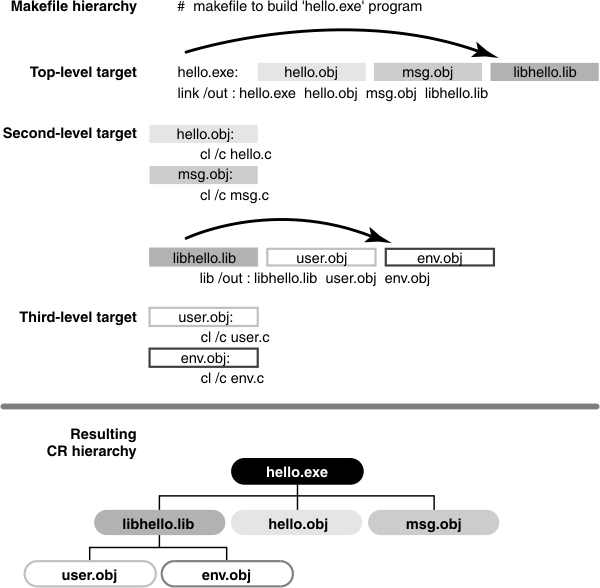Configuration record hierarchies
A typical makefile has a hierarchical structure.
A typical makefile has a hierarchical structure. Thus, running clearmake or omake once to build a high-level target can cause multiple build scripts to be executed and multiple CRs to be created. Such a set of CRs can form a configuration record hierarchy, which reflects the structure of the makefile (see the following figure).

An individual parent/child link in a CR hierarchy is established in one of two ways:
- In a target/dependencies line
For example, the following target/dependencies line declares derived objects
hello.obj,msg.obj, andlibhello.libas build dependencies of derived objecthello.exe:hello.exe: hello.obj msg.obj libhello.lib ...Accordingly, the CR for
hello.exeis the parent of the CRs for the.objfiles and the.libfile. - In a build script
For example, in the following build script, derived object
libhello.libin another directory is referenced in the build script for derived object hello.exe:hello.exe: $(OBJS) cd ..\lib & $(MAKE) libhello.lib link /out: hello.exe $(OBJS) ..\lib\libhello.libAccordingly, the CR for
hello.exeis the parent of the CR forlibhello.lib.Note: The recursive invocation of clearmake in the first line of this build script produces a separate CR hierarchy, which is not necessarily linked to the CR forhello.exe. The second line of the build script links the CR for..\lib\libhello.libwith that ofhello.exeby causing the link to read..\lib\libhello.liband making it a detected dependency.
The catcr and diffcr commands have options for handling CR hierarchies:
- By default, they process individual CRs.
- With the -recurse option, they process the entire CR hierarchy of each derived object specified, keeping the individual CRs separate.
- With the -flat option, they combine (or flatten) the CR hierarchy of each specified derived object.
Some VersionVault features process entire CR hierarchies automatically. For example, when the mklabel command attaches version labels to all versions used to build a particular derived object (mklabel -config), it uses the entire CR hierarchy of the specified DO. Similarly, VersionVault maintenance procedures do not scrub the CR associated with a deleted DO if it is a member of the CR hierarchy of a higher-level DO.